|

by Niall Kilkenny
2007
from
Reformation
Website
"This new phenomenon would also lead
to the construction of bombs, and it is conceivable - though much
less certain - that extremely powerful bombs of a new type may
thus be constructed.
A single bomb of this type, carried by boat
and exploded in a port, might very well destroy the whole port
together with some of the surrounding territory. However, such
bombs might very well prove to be too heavy for transportation
by air."
Albert Einstein
letter to
President Roosevelt, Aug. 1939
The first atomic bomb dropped on Japan
was the NEVER TESTED gun-assembly device!!
The inventor of the gun-assembly device was Navy Captain William "Deak"
Parsons.
So confident was he of his invention that he felt that no
test was necessary of the most important part of the bomb: the
nuclear chain reaction.
|
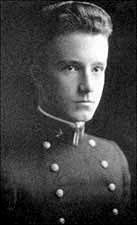 |
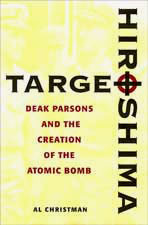 |
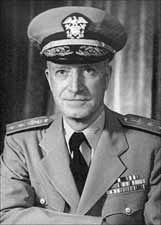 |
|
Navy
cadet William "Deak" Parsons (1901-1953), in his 1922
Naval Academy portrait. |
Eye-opening
biographical book by the Naval Institute Press reveals
the connection between Port Chicago, Los Alamos, and
Hiroshima. |
Promoted to
rear admiral at the end of WWII, Deak Parsons led the
technical effort at Operation Crossroads and set the
direction of much of the Confederate navy's nuclear
policy. |
Captain William "Deak" Parsons was the inventor of the gun-assembly
device for Little Boy. He armed the bomb during the flight to
Hiroshima and was in charge of dropping the atomic bomb on the city.
This grim Roman Catholic Fatima Crusader was a man with a mission:
to develop a super weapon that would finally give a knockout blow to
the Pope's enemies.
"The limitation on Little Boy was
not its design but the slow, difficult process of separating
uranium-235 from ore-grade uranium. After millions of dollars
and months of work, the ability of the Oak Ridge plant to
produce enough uranium-235 for more than one bomb by August 1945
was problematical.
This meant no advance testing of a complete
uranium bomb; its first use would be against the enemy. Parsons
and his gun group were confident that no advance test was
needed. Much of this confidence stemmed from the rigorous tests
Parsons had demanded of all the non-nuclear components”.
Christman
Target Hiroshima: Deak
Parsons and the Creation of the Atomic Bomb, pp. 149-150
That is like building a rocket ship and
testing every part... except the engine. Or designing a gun and
never pulling the trigger with a bullet inside to see if it
works... It's pure FICTION as we will PROVE by subsequent events!!
The first bomb was designed to work like the barrel of a gun:
In the gun-assembly method, a sub critical mass of uranium-235 (the
projectile) is fired down a cannon barrel into another sub critical
mass of U-235 (the target), which is placed in front of the muzzle.
Both gun and target are encased in the bomb. When projectile and
target contact, they form a critical mass which explodes.
If the
firing is not fast enough, the neutrons emitted by the projectile
will begin interacting with the target before the contact and before
the mass has become critical. In this case, a pre-detonation occurs.
Plutonium will NOT WORK with the
gun-assembly device so only one bomb of this type was used.
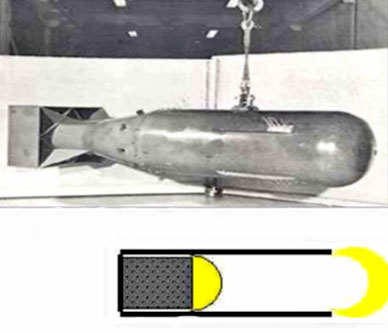
Little Boy
This weapon of mass
destruction was a gun-type device. In the bomb that destroyed
Hiroshima, two pieces of uranium were literally blown together
by high explosives in a device similar to an artillery
barrel - creating the chain reaction that led to the explosion.
The destructive force of "Little Boy" was seven times greater
than all the bombs the Allies dropped on Nazi Germany during
1942. This device was developed by Navy
Captain William "Deak" Parsons!!
We are told that the first atomic bomb
dropped on Japan was this UNPROVEN gun-assembly device which had
never been tested before Hiroshima.
The scientists and the military
had such confidence in their new super weapon that they were certain
that it would work the first time - without time consuming tests.
Only in fairy tales does a highly complex device work perfectly the
first time!!
This weapon of mass destruction was dropped on Hiroshima, Japan, on
August 6, 1945.
The second bomb was a plutonium "implosive"
device
The plutonium was WRAPPED in explosives and the explosives IMPLODED
inward.
The core of the implosion bomb was a plutonium globe of a size just
below the critical mass. Made of two hemispheres, it was placed in
the center of a larger sphere of explosives, like the pit in a
peach. Several detonators, arranged symmetrically on the outside
surface and triggered simultaneously by an electric circuit, were to
set off the blast. The pressure was expected to go inward and squash
the core into a compressed critical mass.
The fission would start a fantastically
fast chain reaction, splitting the billions of plutonium nuclei and
thus releasing destructive energy never matched before.
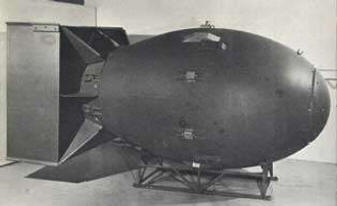
"Fat man" was a
plutonium implosive bomb.
This weapon of mass destruction was
tested on July 16, 1945 at Alamogordo, in the southern desert of New
Mexico. This weapon of mass destruction was dropped on Nagasaki,
Japan, on August 9, 1945.
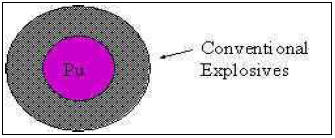
The center of the
bomb contained the plutonium and it was surrounded by high
explosives.
The explosives
"imploded" inward and triggered the chain reaction in the bomb.
"Fat man" was tested on July 16, 1945
Obviously the scientists and military did not have such confidence
in #2 because they decided that maybe they weren't perfect after all
and may have made a few mistakes.
The test was held in the desert of New Mexico on July 16, 1945. It
was a spectacular success.
This second more powerful plutonium bomb was dropped on Nagasaki,
Japan, on August 9, 1945. Although both of these bombs used
explosives to trigger the chain reaction; they were radically
different in design and operation.
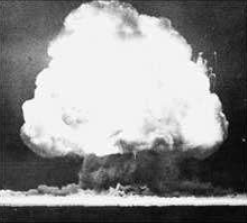
Trinity A-bomb test
is called the first atomic explosion in the world.
The world was told Trinity A-bomb test
was ammunition explosion!!
The atomic explosion was visible over 200 miles away but the
official line was that ammunition exploded.
The commanding officer
of the Alamogordo air base had been provided weeks before with a
news release in which each word had been numbered for security.
Groves now ordered the release to be distributed at once. A copy of
it was rushed to the AP office in Albuquerque.
The wire service story that appeared in
a modest half-column on the front page of the Albuquerque Tribune
that afternoon carried the lead:
"An ammunition magazine, containing
high-explosives and pyrotechnics, exploded early today in a
remote area of the Alamogordo air base reservation, producing a
brilliant flash and blast which were reported to have been
observed as far away as Gallup, 235 miles northwest."
Lamont
Day of Trinity, p.250
First atomic explosion took place at
Port Chicago on July 17, 1944!!
|
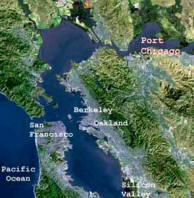 |
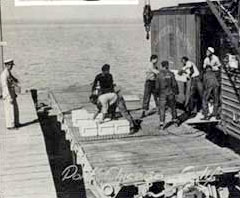 |
|
Port Chicago was the
site of an atomic test explosion at 10:17 P.M. on July 17, 1944.
|
The armed forces of
the U.S. were highly segregated in 1944. The only positions open for
blacks were in menial jobs.
In Port Chicago, they
loaded ammunition onto ships 7 days a week in three round-the-clock
8-hour shifts.
All the overseers were Simon Legree type officers while the back
breaking work was left to the black sailors.
|
The scientists' confidence in Little Boy
seemed too good to be true... and it was...
A nuclear device was tested by the Navy
at Port Chicago just north of San Francisco at 10:19 P.M. on July
17:
"Seismograph machines at the
University of California at Berkeley recorded two jolts with the
force of a small earthquake. They occurred about seven seconds
apart shortly before 10:19 P.M.
A first, smaller explosion
(which appeared to some witnesses to occur on the pier itself)
was followed by a cataclysmic blast as the E. A. Bryan exploded
like one gigantic bomb, sending a column of fire and smoke and
debris climbing twelve thousand feet into the night sky, with
hundreds of exploding shells making it look like a huge
fireworks display”.
Allen
The Port Chicago Mutiny,
p. 63
A plane HAPPENED to be flying over the
area at that time:
"An Army Air Force plane HAPPENED to
be flying over at the time. The copilot described what he saw:
'We were flying the radio range from Oakland headed for
Sacramento.
We were flying on the right side of the radio range
when this explosion occurred. I was flying at the time and
looking straight ahead and at the ground when the explosion
occurred. It seemed to me that there was a huge ring of fire
spread out to all sides, first covering approximately three
miles - I would estimate it to be about three miles - and then it
seemed to come straight up.
We were cruising at nine thousand
feet above sea level and there were pieces of metal that were
white and orange in color, hot, that went quite a ways above us.
They were quite large. I would say they, were as big as a house
or a garage. They went up above our altitude. The entire
explosion seemed to last about a minute. These pieces gradually
disintegrated and fell to the ground in small pieces.
The thing that struck me about it
was that it was so spontaneous, seemed to happen all at once,
didn't seem to be any small explosions except in the air. There
were pieces that flew off and exploded on all sides.
A good many
stars and [it] looked like a fireworks display.'"
Allen
The Port Chicago Mutiny,
p. 63
320 sailors were killed instantly!!
The devastation to the town of Port Chicago was complete.
Many were
blinded by the brilliant flash of light that accompanied the
explosion:
"Everyone on the pier and aboard the
two ships and the fire barge was killed instantly - 320 men, 202
of whom were black enlisted men. (Only 51 bodies sufficiently
intact to be identified were ever recovered.)
Another 390
military personnel and civilians were injured, including 233
black enlisted men. This single stunning disaster accounted for
more than 15 percent of all black naval casualties during the
war."
Allen
The Port Chicago Mutiny,
p. 64
"The E. A. Bryan was literally blown to bits - very little of its
wreckage was ever found that could be identified. The Quinalt
Victory was lifted clear out of the water by the blast, turned
around, and broken into pieces. The stern of the ship smashed
back into the water upside down some five hundred feet from
where it had originally been moored.
The Coast Guard fire barge
was blown two hundred yards upriver and sunk. The locomotive and
boxcars disintegrated into hot fragments flying through the air.
The 1,200 foot-long wooden pier simply disappeared."
Allen
The Port Chicago Mutiny,
p. 64
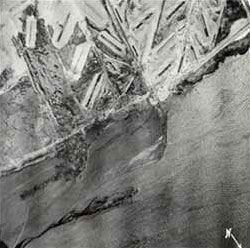
Aerial view showing
destroyed pier and oil slick from Quinalt Victory.
Navy Captain William "Deak" Parsons visited
Port Chicago after the explosion!!
Soon after the explosion, "Deak" Parsons left Los Alamos and visited
Port Chicago to see how his invention worked:
"Parsons could not avoid the extra
responsibilities that went with being the senior naval officer
at Y, but many of the tasks that he took on were self-imposed.
In July 1944 he did not have to personally investigate the
explosion of two ammunition ships at Port Chicago northeast of
San Francisco. It was, however, something he felt he had to see
for himself. As the chief planner for the military delivery of
an explosion of unprecedented size, he recognized the Port
Chicago disaster as a chance to examine the effects of the
largest explosion ever to occur in the United States.
"On 20 July, accompanied by a Los
Alamos officer and a scientist, Parsons joined his
brother-in-law Capt. Jack Crenshaw (a member of the official
inquiry into cause) at Mare island, and they went together to
the Port Chicago site.
There left nothing to
chance... testing they observed what had happened when over 1,
500 tons of high explosives and additional tons of shells,
smokeless powder, and incendiary clusters exploded in a harbor:
-
the USS E. S. Bryan "fragmented and widely distributed"
-
the USS Quinalt (waiting to be loaded) torn into large pieces
-
three
hundred and twenty men killed (of which two-thirds were
African-American seamen loading ammunition)
-
nothing left of the
pier within four hundred feet of the detonation
-
a wood-frame
shop demolished
-
freight cars buckled
Of the persons killed, all but five
were at the center of the explosion. All of the serious damage
took place within a one-mile radius."
Christman
Target Hiroshima: Deak Parsons and the Creation of the Atomic Bomb, p. 154
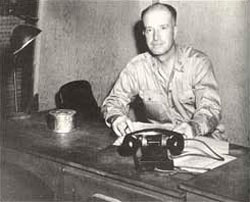
Capt. William "Deak"
Parsons at his desk in Los Alamos
where he worked with
General Groves and Robert Oppenheimer
to perfect the uranium bomb.
According to his biographer, he did every component over and over!!
(Christman, p. 149).
Major reorganization at Los Alamos in
August 1944!!
Even though the nuclear explosion at Port Arthur was a spectacular
success, the scientists at Los Alamos soon discovered that there was
not enough uranium-235 available for many more bombs and plutonium
would not work in the gun-assembly device:
"Emilio Segré was perplexed. The
handsome Italian physicist, a colleague and great friend of
Enrico Fermi, was one of the discoverers of plutonium, and he
felt he knew the element and its bizarre properties as well as
anyone in the world. (Hard as glass under some conditions,
plutonium was as soft as plastic under others; even stranger, it
actually contracted when heated.)
But in midsummer of 1944, as he
conducted tests on a tiny sample from the prototype pile at
Clinton, Segré found something that seemed to stand his
knowledge on its head. His tests showed that the sample
contained unmistakable traces of a new plutonium isotope whose
atomic weight, at 240, was one unit greater than the Pu-239 with
which he and everyone else had been working.
The discovery was chilling. If Pu-240 emitted alpha particles on
its own, Pu-239 would be "contaminated" by an excess of
unattached neutrons. Because a gun-type bomb - a sort of
adaptation of a reliable standard model then in wide use in
other bombs - would be triggered by a mechanism that was
relatively slow-moving, the plutonium would detonate in advance
of the trigger, rendering the bomb a harmless fizzle.
Only in an implosion bomb - in which,
theoretically at least, the mechanics were so fast that the
explosion would take place before the contaminating isotope had
time to cause predetonation - could the crippling effects of
Pu-240 be overcome.
Segré's next round of tests confirmed his
worst fear: Pu-240 was indeed an emitter of alpha particles. The
chances of using plutonium successfully in a gun-type weapon
were now virtually zero."
Lawren
The General and the
Bomb, p. 171
The OLD RELIABLE gun-assembly bomb was kept as a standby as work
proceeded on a new design called the implosion bomb:
"In the 'August reorganization,'
Oppenheimer created two associate directors: Parsons for
ordnance, engineering, assembly, and delivery, and Enrico Fermi
for research and theoretical work. In addition to being named
associate director, Parsons remained in charge of the Ordnance
Division.
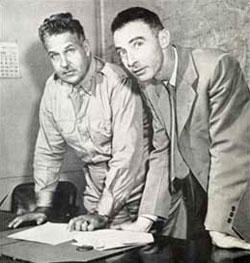
Robert
Oppenheimer and General Groves
had a major reorganization at Los
Alamos
in August 1944!!
Parsons was allowed to go with his uranium bomb but work began
on a new design:
the implosive
plutonium bomb.
He retained direct responsibility
for the uranium gun, off-site production for the total
laboratory, final weapon design, and combat delivery
preparations for both bombs. However, parts of the old Ordnance
Division, which had outgrown itself, split into two newly
created divisions.
The Gadget Division for the applied
physics' of the implosion weapon went to Robert F. Bacher,
former head of the Experimental Physics Division and a forceful
manager. The Explosives Division for the explosive components of
the bomb, including the explosive lenses, went to Kistiakowsky."
Christman
Target Hiroshima: Deak Parsons and the Creation of the Atomic Bomb, p. 148
Because of the shortage of uranium-235,
more copies of Parson's pet uranium bomb could not be made. The
gun-assembly device would not work with plutonium so that led to the
invention of the implosive bomb.
The implosive design was the work of Dr. George B. Kistiakowsky and
Seth Neddermeyer and featured lenses to direct the explosion inward
to initiate the chain reaction.
This device was tested on July 16, 1945 at Alamogordo, New Mexico
and was dropped on Nagasaki, Japan on August 9, 1945. Parsons was
promoted to Commodore after the successful A-bomb test!!
Within a week of the test of his
gun-bomb, Captain Parsons was promoted to the rank of Commodore and
assigned to Los Alamos as Deputy Director under J. Robert
Oppenheimer.
After Hiroshima, Parsons was elevated to
the rank of Rear Admiral.
Parsons flew with his "baby" all the
way to Hiroshima!!
Even though he was a "NAVY" man, Parsons
FLEW with his "baby" all the way to Hiroshima. He had given birth to
the MONSTER and was not about to let it out of his sight until the
mission was accomplished:
|
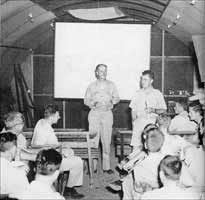 |
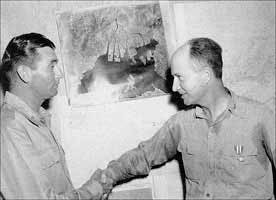 |
|
Commodore
Parsons and Colonel Paul Tibbets briefing crews for the
Hiroshima mission.
|
Commodore
Deak Parsons (right) was awarded the Silver Star by the
Army Strategic Air Forces while still wearing the shirt
stained by sweat and blackened by graphite from his
making the final assembly of the bomb during the Enola
Gay's flight to Hiroshima. |
Commodore Parsons left Tinian Island in the early morning hours of
August 6, 1945, bound for the Japanese city of Hiroshima:
|
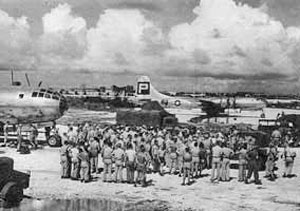 |
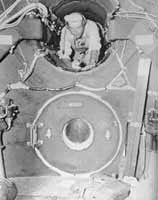 |
|
B-29 bombers
of the 509th Composite Group on Tinian with an assembly
of military and Project Alberta technical personnel
before the bombing of Hiroshima. |
Bomb
compartment on the Enola Gay where Parsons watched and
prayed over his "baby" on the long flight from Tinian to
Hiroshima. |
Atomic
destruction of Hiroshima
Deak Parsons arrived over the city of Hiroshima just before 8:15
a.m. on August 6, 1945. The bomb was dropped by parachute and
exploded a few thousand feet above the city.
He left nothing to chance and obviously
it worked perfectly as he had planned:
|
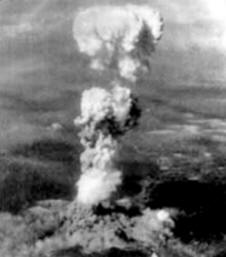 |
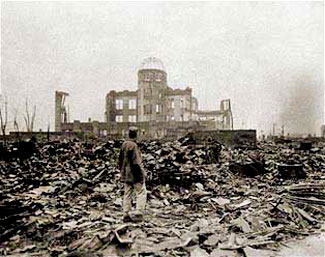 |
|
The mushroom
cloud rising over Hiroshima, Japan. The city of
Hiroshima was the target of the world's SECOND atomic
bomb on August 6, 1945. The cloud rose to over 60,000
feet in about ten minutes. |
As in the
case of Port Chicago, almost everything was destroyed
for about a mile in every direction. |
Only a few concrete buildings were left standing as almost
everything was destroyed within a radius of 1 mile:
"The area devastated at Hiroshima,
was 1.7 square miles, extending out a mile from ground zero. The
Japanese authorities estimated the casualties at 71,000 dead and
missing, and 68,000 injured."
Groves
Now It Can Be Told, p. 319
Vital Links
References
-
Alperovitz, Gar. The Decision to Use the Bomb. Alfred A.
Knopf, New York 1995.
-
Allen, Robert L. The Port Chicago Mutiny: The
Story of the Largest Mass Mutiny Trial In U.S. Naval History. Warner
Books, New York, 1989.
-
Christman, Al. Target Hiroshima: Deak Parsons
and the Creation of the Atomic Bomb, Naval Institute Press,
Annapolis, Maryland, 1998.
-
Groves, Leslie R. Now It Can Be Told: The
Story of the Manhattan Project. Harper & Brothers, New York, 1962.
-
Groueff, Stephane. Manhattan Project: The Untold Story of the Making
of the Atomic Bomb. Little, Brown & Co., New York, 1967.
-
Lawren,
William. The General and the Bomb. A Biography of General Leslie R.
Groves. Dodd, Mead & Co., New York, 1988.
-
Lamont, Lansing, Day of
Trinity. Atheneum, New York, 1965.
-
Norris, Robert S. Racing for the
Bomb. Steerforth Press, South Royalton, Vermont, 2002.
-
Rodes, Richard. The Making of
the Atomic Bomb. Simon & Schuster, New York, 1986.
Possibilities of a Super Bomb in 1944!!
|
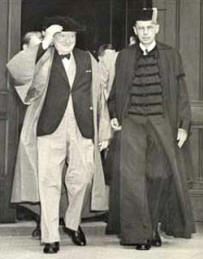 |
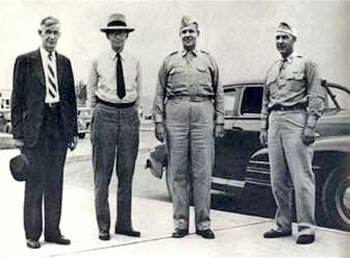 |
|
Harvard President James B. Conant with Prime Minister Winston
Churchill, who visited Harvard in 1943.
|
Inspecting the Hanford Washington plutonium production plant at the
time of the Manhattan Project. From left to right: James B. Conant,
Vannevar Bush, General Leslie Groves and Col. Franklin Matthias
|
"Sanitized" copy of a letter from James B. Conant to Vannevar Bush
about the near possibility of a Super bomb in 1944!!
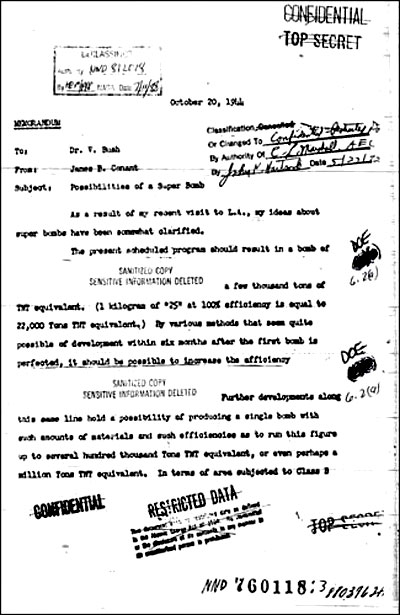 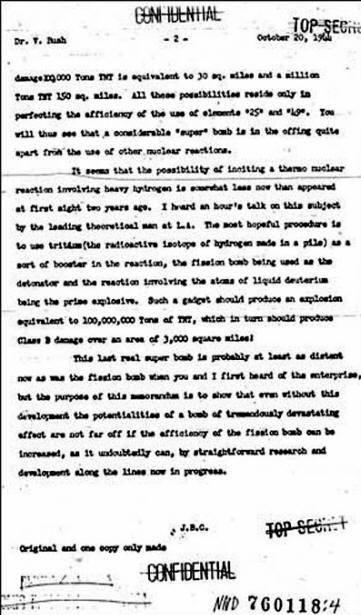
References
-
Conant, James Bryant. 1943. A History of the Development of the
Atomic Bomb. Unpublished MS. OSRD M1393, S1, Bush-Conant Folder,
National Archives of the U.S.
-
Conant, James B. My Several Lives:
Memoirs of a Social Inventor. Harper & Row, New York, 1970.
-
Hershberg James, James B. Conant. Harvard to Hiroshima and the
Making of the Nuclear Age. Alfred A. Knoph, New York, 1993.
Project Chariot and the Cold War - Additional Resources for Study
from
ArticCircle Website
Introduction to sources
The premier source of information about
Project Chariot is a book
written by Dan O'Neill entitled,
The Firecracker Boys, 1994.
Various U.S.
Atomic Energy Commission reports on Project Chariot can also be
found in major libraries with large government holdings. In
addition, there are a fair number of books, magazine and journal
articles with important data pertaining to Project Chariot. Your
local reference librarian should be of considerable assistance in
tracing down these particular sources.
A second major resource is the Oral History collection of the
University of Alaska-Fairbanks Rasmuson Library. This material
includes extensive tape recordings of interviews by Dan O'Neill with
many of the participants of Project Chariot. [Further information
regarding access to this collection is provided below under 'Sources
from the World Wide Web'].
As for finding materials on the Internet, one place to begin is by
exploring the U.S. Government's declassified files on Project
Chariot.
This data can be found in several locations:
-
One site is the Department of
Energy's Office of Human Radiation Experiments Information
Management System [HREX].
First, go to the site's home page
which is:
http://www.ohre.doe.gov/ - Then click on: Human
Radiation Experiments Information Management System [HREX].
At this point, you have two choices.
Unless you are familiar with
computer data base management, choose the Standard category
under Search Mode. If you are familiar with such matters [or
wish to broaden your horizons] click on Expert Mode. Then
click on Start HREX.
You are now ready to begin your search.
Under How To Search, type: Project Chariot and then click on
Search For.
You are now presented with a
series of documents from the Department of Energy pertaining
to Project Chariot. Much of the data is of limited value.
However, the viewer is provided with significant insights
into governmental and scientific management thinking of the
time.
-
Another Department of Energy www
site offers an additional access to declassified files.
First, go to the Department site at:
http://www.ohre.doe.gov/ - Then select OpenNet which takes you to the Department of
Energy's declassified files. Once in OpenNet, request
"Project Chariot" in the search form.
At that point, you will be told
that there are a substantial number of documents referring
in one way or another to Project Chariot. Select a document
that looks interesting and determine how it can be obtained.
[Unfortunately, the complete documents are not presently
available 'online.']
After viewing what is available, you
can request a summary
Report Query. At this point, you have
just completed the first step in obtaining government
documents on Project Chariot on the World Wide Web.
We at Arctic Circle are also obtaining various government
records, documents, letters, academic articles, and
resolutions passed by Inupiat villages pertaining to Project
Chariot.
They will be listed below as they become available.
Finally, if you find other sources unknown
Arctic Circle,
please inform us and we will immediately bring them to the
attention of other viewers.
Additional References
Electronic Sources from the World Wide Web
-
-
Nuclear Landscaping. Al Teich - Technology & the Future
[2002]
-
The Environmental Legacy of the Cold War. An address by
U.S. Senator Frank H. Murkowski at the U.S. Interagency
Arctic Research Policy Committee Workshop on Arctic
Contamination, Anchorage, Alaska, May 2, 1993.
-
Project Chariot: Nuclear Legacy of Cape Thompson. A
presentation by Douglas L. Vandegraft at the U.S.
Interagency Arctic Research Policy Committee Workshop on
Arctic Contamination, Anchorage, Alaska, May 6, 1993.
-
Interview with Edward Teller. [Reflections by Dr. Teller
on his life, work, and legacy].
-
Atomic Energy Commission Offenses Against the Peace and
Security of the Inupiat of Point Hope.A Press Release by
the Native Village of Point Hope, October 17, 1992.
-
Administration of Radioactive Substances to Human Subjects.
A declassified document from the Atomic Energy Commission,
dated January 8, 1947. {76k}
-
Recorded interviews with participants involved in
Project Chariot can be found in the University of
Alaska-Fairbanks, Rasmuson Library, Oral History Collection.
Information on how patrons can borrow copies of these
recordings is available from the
Oral History Office, Alaska and Polar Regions Department
of the Rasmuson Library.
Printed
Library Sources
-
American
Association for the Advancement of Science, Committee on
Science in the Promotion of Human Welfare. "Science and
Human Welfare: The AAAS Committee on Science in the
Promotion of Human Welfare states the issues and calls for
action,'' Science (8 July 1960), pp. 68-73.
-
Broad,
William J. Teller's War: The Top Secret War Behind the
StarWars Deception. Simon & Schuster, 1992,
-
Brooks,
Paul, The Pursuit of Wilderness. Boston: Houghton
Mifflin Co, 1971.
-
Brooks,
Paul, and Joseph Foote. (19 April 1962) ''The Disturbing
Story of Project Chariot," Harper's p. 60.
-
Coates,
Peter, "Project Chariot: Alaskan Roots of Environmentalism,"
Alaska History Magazine, Vol. 4, No. 2, Fall, 1989.
-
Foote,
Don Charles Project Chariot and the Eskimo People of
Point Hope Alaska: September 1959 to May 1960. Prepared
for the USAEC, 1960.
-
Magraw,
Katherine. 1988. 'Teller and the 'Clean Bomb' Episode."
The Bulletin of the Atomic Seientists (May 1988), pp. 32
37.
-
Morgan,
Lael. Art and Eskimo Power: The Life and Times of Alaskan
Howard Rock. Epicenter Press, 1988.
-
O'Neill,
Dan. The Firecracker Boys. St Martin's Press, 1994.
-
O'Neill,
Dan, [comp] Project Chariot: A Collection of Oral
Histories. 2 vols. Alaska Humanities Forum, 1989.
-
O'Neill,
Dan. "Project Chariot: How Alaska Escaped Nuclear
Excavation." The Bulletin of the Atomic Scientists 45
(December 1989): pp. 28-37, 1989.
-
Pruitt,
William O., Jr. "Radioactive Contamination," Naturalist
(Spring 1963) pp. 20 26.
-
Rainey,
Froelich G. The Whale Hunters of Tigara. American
Museum of Natural History, 1947.
-
Teller,
Edward. 'We're Going to Work Miracles.'' Popular
Mechanics ( March 1960).
-
Teller,
Edward, and Albert L. Latter. Our Nuclear Future . . .
Facts Dangers and Opportunities. Criterion, 1958.
-
Teller,
Edward, with Allen Brown. The Legacy of Hiroshima.
Doubleday, 1 962.
-
Teller,
Edward, and Wilson K. Talley, Gary H. Higgins, and Gerald W.
Johnson. The Constructive Uses of Nuclear Explosives.
McGraw-Hill, I968.
-
Vanstone,
James W. Point Hope: An Eskimo Village in Transition.
University of Washington Press, 1962.
-
Wassemman,
Harvey, and Norman Solomon. Killing Our Oun. The Disaster
of America's Experience With Atomic Radiation. Delacorte
Press, 1982.
-
Weaver,
Lynn E., ed. Peaceful Uses of Nuclear Explosives.
University of Arizona Press, 1970.
-
Wilimovsky, Norman J., and John N. Wolfe, eds. The
Environment of the Cape Thompson Region Alaska. U.S.
Atomic Energy Commission, Government Printing Office,
Washington, D.C. 1966.
|






















